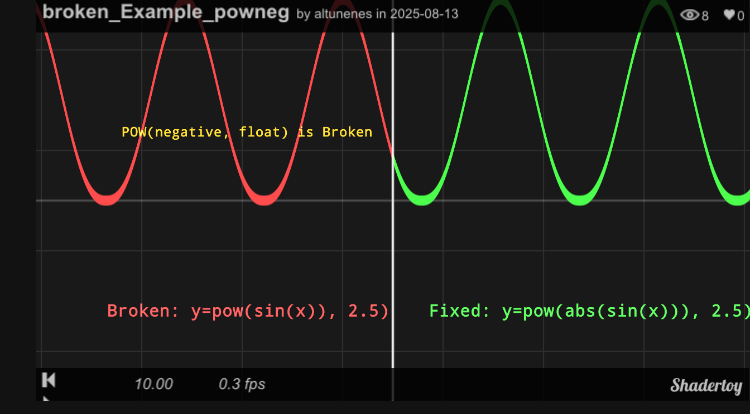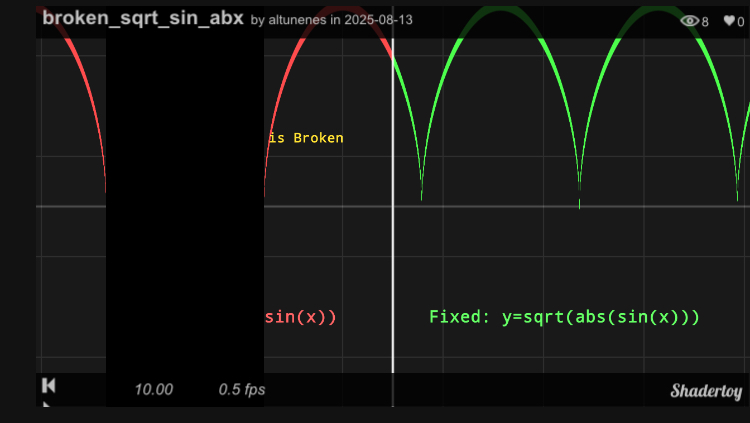Table of Contents
Why Shaders Turn Black: negatives in pow() and sqrt()
Black pixels appearing in a shader often trace back to a mathematical domain error. The most common sources are the sqrt() and pow() functions when they receive invalid inputs.
In GLSL, sqrt(x) is undefined if x is negative. Similarly, pow(x, y) is undefined if x is negative and y is not an integer. When asked to perform an undefined operation, most GPUs return NaN (Not a Number). Any further math involving this NaN also results in NaN, and the renderer typically draws these pixels as black. To make matters worse, compilers often won't warn you about this potential problem, making the bug difficult to trace in a complex shader.
Visualizing the Error and the Fix
The following demos show the problem in action. The left side (red) performs the math naively. The right side (green) uses abs() to prevent errors.
1. The sqrt() Domain Error
Graphing y = sqrt(sin(x)). The gaps on the left show where sin(x) is negative and the math fails.
2. The pow() Domain Error
Graphing y = pow(sin(x), 2.5). The same issue occurs, breaking the function where the base is negative.
*Note: If a shader appears broken, try refreshing the page as Shadertoy can sometimes be unstable.*
This variance across platforms, which can depend on the GPU hardware or its drivers, is a key reason to handle these edge cases proactively with abs() or other methods, as the output is not guaranteed. For example, while most desktop GPUs produce clean gaps, some GPUs (like on an iPhone 6s in the example below) handle the error differently. Notice how the sqrt() error is avoided entirely, but the pow() error still renders artifacts—not as empty gaps, but this time as large black columns!


The Technical Reality Behind the Error
Using abs() fixes the black pixels, but it's crucial to understand why the failure occurs to write better code.
GPUs don't calculate powers through repeated multiplication. For performance, they use the mathematical identity: pow(x, y) = exp2(y * log2(x))(see ref). The failure point is log2(x). The logarithm of a negative number is undefined in the real number system. Therefore, any negative x passed to pow() causes the internal calculation to fail and produce a NaN.
While abs() prevents NaNs, it can introduce silent mathematical bugs. Consider (-2)³, which should be -8.
pow(-2.0, 3.0)might fail due to thelog/expimplementation.pow(abs(-2.0), 3.0)will incorrectly return8.
This error can invert lighting or break procedural patterns. When you need to preserve the sign for odd integer powers, the correct pattern is:
float result = pow(abs(x), y) * sign(x);
A conditional check like if (x >= 0.0) might seem safe, but it's a performance trap. Branches cause 'thread divergence' on GPUs, hurting the parallelism that makes them fast. Branchless functions like abs(), max(), and sign() are far more efficient (see: theorangeduck, See: 3). Writing robust shader code means handling these cases smartly. For integer powers, explicit multiplication like x*x is always better than pow(x, 2.0) [1,2]. It's faster and avoids the log/exp path entirely. To prevent floating-point errors from creating negative inputs later, proactively clamp values with max(value, 0.0) or saturate(value), especially after operations like dot(). Finally, use abs() with care. It's a tool for getting a magnitude, not a universal patch. If you need to preserve a negative sign with an odd power, the sign(x) * pow(abs(x), y) pattern is the mathematically correct approach.
References
[1] Khronos Forums Discussion: "Pow(x, 2) different then x*x?"
Cite:
Altun, E. (2025, August 13). Why Shaders Turn Black: negatives in pow() and sqrt(). Retrieved from https://altunenes.github.io/posts/forbidden/